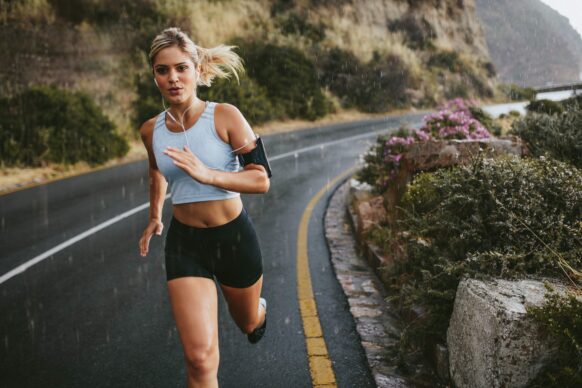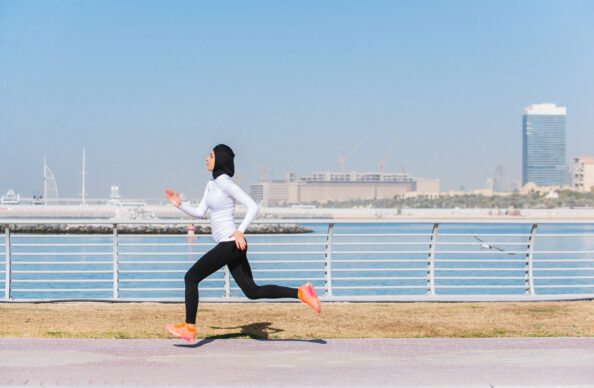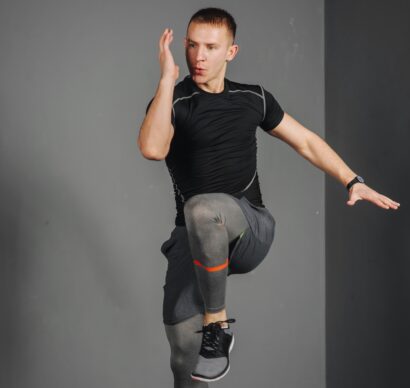by Mike Herrera, DPT
Running challenges our body with multiple demands, each playing a significant role in supporting one another, from balance to core to glute to the cardiovascular system. Each area will support you from start to finish as efficiently as your body allows.
The role of the foot and ankle is vital, as it’s what connects us to the ground and allows us to utilize our glute and core up the kinetic chain. If you want to improve balance, combine single leg stability drills, lower leg strengthening and learning to screw your big toe into the ground without taking that motion from your rear foot.
The foot and ankle also must be mobile to allow for an increased ability to be variable and problem-solve as our foot strikes the ground on a variety of, and ever-changing, surfaces.
The Foot Tripod Standing barefoot on one foot, what do you notice? Is there a shift to the outside of your foot? Do you collapse into your medial arch? Or do you keep even pressure across your foot tripod while standing?
Each of the possible results tells us a different story. If your weight is unevenly distributed across your foot tripod, things we would look into during Physical Therapy include discerning limitations of the lateral band in the plantar fascia and restrictions with foot coordination and muscle weakness within the foot.
Ankle Dorsiflexion Ankle dorsiflexion is essential in the running and walking gait. Without enough dorsiflexion, one becomes unable to fully reap the benefits of the kinetic energy created in the gait cycle. With improved dorsiflexion, you can become more efficient and increase the fascial stretch/kinetic energy to allow improved distribution of forces demanded by running.
Ankle Controlled Movements and Strength As we strike the ground in our running gait, our foot/ankle must adapt to the quick impact to allow good distribution up the kinetic chain. Our lower leg musculature needs to not only have the strength for this, but the motor control to eccentrically control its movement. Without this, imagine your heel slamming to the ground without any muscle support. As you learn to improve this eccentric control, not only will you be better at distributing forces, you’ll also allow for increased utilization of the kinetic energy in the lower leg while improving balance along the way.
Putting It All Together Hip Closed Kinetic Chains Controlled Rotations continue to be one of my favorite drills for runners. As research continues to show, your exercises should be sport-specific to make them most effective for translating to your performance. With this drill, you’re utilizing your foot tripod and assuming a running stance while actively controlling hip internal and external rotation. In our running cycle, we must become extremely skilled at controlling our body from the ankle all the way up the chain to, and beyond, our lumbopelvic stability.
Give the following exercises a try. As you become increasingly able to control your foundation at the ground, you’ll be better able to progress up the chain to other single leg balance exercises highlighted in our post here: Single Leg Balance Drills for the Runner.
Ankle Mobilization (2 sets x 10 reps) Anchor superband to ankle. With constant pressure, drive your knee straight forward. Pause and hold at max dorsiflexion.
Ankle Warm-Up (2 laps x 15 yards) Walking forward, perform a dynamic single leg heel raise. Control the heel as you raise it and control lowering your heel back to the floor. As you walk forward, try to maintain a neutral foot and maintain balance and control.
Eccentric Heel Raises (3 sets x 15 reps each side) Raise your body with two feet, lift off one foot, then perform slow and controlled lowering of your target ankle. Progress as appropriate.
Heel Lift Off (2 sets x 10 reps) Perform first set with leg straight; second set with leg bent. Hold each rep for 5 seconds.
Hip CKC Controlled Rotations (1 set x 10 reps each side) Maintain equal pressure on your heel, ball of your big toe and ball of your little toe. In single leg stance, proceed to controlled hip rotations as if to “show off your belt buckle.”
If you notice any restrictions or imbalance, please reach out for an appointment with a physical therapist to help improve.




